| Electric tramcars on the
South Staffordshire and Birmingham District Tramways Company
Limited, Later South Staffordshire Tramways Company Limited. |
|
Plans for
Electrification
The company decided that electric
traction was the way forward as early as 1888. The seventh
annual meeting took place in the company's offices at
Darlaston depot on 29th March, 1888. At the meeting the directors
agreed to promote a Bill to incorporate the company in order to extend the company’s
operating powers, and to use electric traction on the
network. This resulted in the passing of the South
Staffordshire Tramways Act, 1889 which allowed the company
to be incorporated as the South Staffordshire Tramways
Company. The Act also allowed the company to borrow a
maximum of £50,000.
The following officials were present at
the meeting:
Chairman - W. J. Carruthers Wain
Directors - W. Busby, C. E. Davison, C. James, and the newly
appointed F. H. Lloyd
Company Solicitor - Joseph Smith
General Manager - Alfred Dickinson
Company Secretary - H. Hatchett
Mr. W. J. Carruthers was also Managing
Director of the Birmingham Tramways Company.
Mr. Alfred Dickinson was also
consulting engineer to the Birmingham Tramways Company, and
the Birmingham Cable Tramway Company.
Mr. Joseph Smith, who had previously
been Town Clerk of Wednesbury was also Chairman of the
Birmingham Tramways Company, and Managing Director of the
Electric Construction Corporation Limited of Wolverhampton. In October 1890
he went on a fact finding tour of the United States of
America to look at electric tramway systems in the country,
and while there gave a talk to the American Street Railway
Association about English tramways. Around this time he
changed his name to Joseph Ebbsmith.
Mr. W. J. Carruthers Wain and Mr Joseph
Smith were two of the key founders of the Tramways Institute
of Great Britain and Ireland. Mr. W. J. Carruthers Wain
became President of the Institute.
On 4th March, 1891 at the company's
annual meeting, the chairman stated that running costs had
increased to 12.71 pence per mile, in spite of rigorous
economies. The directors felt that the only sensible way to
reduce running costs was to use an overhead electric wire
system. The company had already contacted a number of
electrical firms who had sent representatives to see what
was possible, and were expecting to receive proposals and
quotations. The company produced an elaborate
booklet entitled "Electric Traction for Ordinary Tramways,
Descriptive Pamphlet, 1891". It extolled the virtues of
electric traction and stated that the company was ready to
recommend that shareholders should agree to electrifying the
tramway from Bloxwich to Wednesbury via Walsall using an
overhead wire.
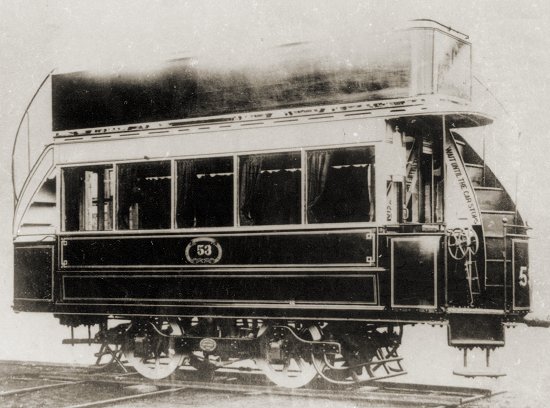
A South Staffs electrically-powered
tramcar.
In April 1891 the company approached
both Walsall and Wednesbury councils to ask permission to
electrify the tramway from Walsall to Wednesbury, and
Walsall to Bloxwich, using a system of overhead wires.
Wednesbury Council immediately agreed to the proposal, but
Walsall insisted that the company should pay the expenses of
Walsall Corporation's adviser on electric traction, Mr.
Frederick Brown, for a fact-finding trip to the USA to investigate the
various systems in operation there. The company agreed and
also sent Alfred Dickinson along to gather information.
During three weeks in May and June 1891 the pair travelled
about 4,000 miles around the country and visited all of the
main networks.
On his return, Alfred Dickinson stated
that he preferred either the Thompson-Houston or the
Edison-Sprague system, and applied to the Darlaston Local
Board for permission to electrify the line from Darlaston to Mellish
Road, Walsall. Mr. Brown submitted a report to Walsall
Corporation in which he stated that the overhead system of
electrical traction called the trolley system, would be the cheapest, safest, and most efficient
means of running street cars. He thought that the side pole
and span wire system would be the most suitable for use in
Walsall.
Alfred Dickinson presented a paper to
the Tramways Institute of Great Britain and Ireland, on 30th
December, 1892, in which he stated that the only methods of
electric traction to consider were the accumulator, conduit,
and overhead wire systems, only the latter of which had so
far proved to be perfectly satisfactory.
On 17th September, 1891 an
extraordinary company meeting was held to decide upon the
methods to be used to raise the required capital needed to
electrify the network. It was decided that the required
amount would be borrowed by taking out a mortgage on the
company's undertaking.
At that time the only overhead wire
system in operation in the country was at Leeds on the
Roundhay Line. The town councils sent a deputation to Leeds
to inspect the line. After the inspection, it was felt that
the overhead wires in use at Leeds were unsightly and so
unsuitable for use. Alfred Dickinson however, had already
been considering this problem, and on 28th March, and
21st December, 1891 he submitted patent applications for
"Improvements in masts and trolleys for the Overhead
System". On 13th February, 1892 a patent was granted for a
mast or arm fitted to the tramcar by a ball and socket
joint, and controlled by springs, so that it could swing in
any direction. The trolley would be kept in position under
the wire by guides extending above the wire, which were
sprung on hinges so as to pass obstructions. His successful
design became the standard, and fore-runner of the later
swivel-head trolleys used on trolley buses.
Alfred Dickinson's design was submitted
to the local authorities, and unanimously approved. The
company agreed that wherever possible, the poles with the
bracket arms for carrying the trolley wire would be placed on the site of existing gas lamps, and would
carry the gas lamp. This would reduce the number required
and reduce the amount of street clutter. The
routes would also be single track with passing places in
order to reduce the amount of overhead cabling.
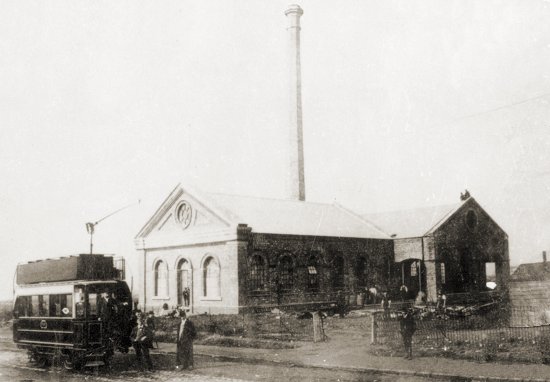
Pleck electricity generating station.
In 1892 the company entered into a
contract with the Electric Construction Corporation Limited,
Wolverhampton for the equipping of the company's lines from
Walsall to Wednesbury, Darlaston, and Bloxwich, and the
building of an electricity generating station at Pleck. E.C.C.
would also supply all of the electrical equipment and
tramcars, maintain the network, and operate the services for
a period of five years. Payment was to be by a fixed charge
per car mile. The company had close links with the E.C.C.
through its secretary, Joseph Ebbsmith who was Managing
Director of E.C.C., and Alfred Dickinson who had worked
closely with the firm during its installation of the the
electrical equipment for the Bristol Road accumulator
tramway in Birmingham. The work would be personally supervised
by the E.C.C.'s Manager and electrical engineer, Mr. Thomas
Parker.
Work in Progress
By April 1892 the E.C.C. were
manufacturing equipment for the line, and by August, poles
were being erected along the streets. The mild steel poles
were made by James Russell & Sons Limited at Wednesbury,
and John Russell & Company Limited at Wednesbury and Walsall. Part of the
Darlaston depot was equipped for electric traction, as was
part of Birchills Depot.
The generating station was built
alongside Darlaston Road at Pleck, adjacent to the Walsall
branch of the canal from where coal could be delivered
directly to the building, and water used to condense steam. There were three 120psi Lancashire-type boilers and
three 125hp. horizontal-coupled compound steam engines, all
made by Musgrave & Sons of Bolton. The engines had Corliss
valve gear and each drove an Elwell-Parker type shunt-wound
dynamo via multiple cotton ropes. The dynamos each provided
350 volts DC at 260 amps at a speed of 450 rpm. Only two of
the engines and dynamos would be in use at any one time, feeding
350 volts to the line via a switchboard.
The trolley wire was roughly divided
electrically into half mile sections, each fed from a cable
beneath the road, and a fusebox under the pavement, adjacent
to the nearest pole.
The rolling stock consisted of 16
double deck cars, 8 built by Brown, Marshall & Company, and
8 built by the Lancashire Carriage and Wagon Company. They
seated 18 passengers inside, 22 outside, and weighed 6
tons 13 cwt.
The prestigious engineering magazine, 'The Railway
Engineer' was very sceptical about the project. The January
1893 edition carried the three short articles below:
|
|
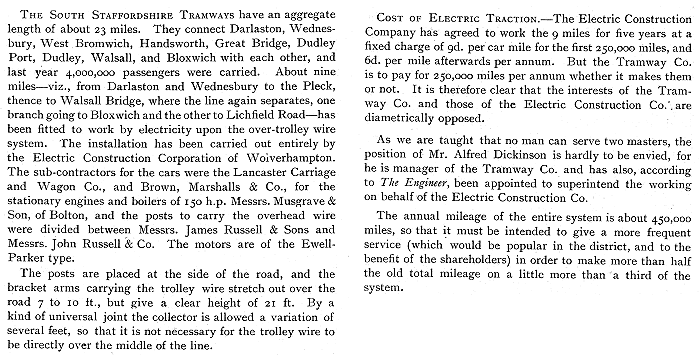 |
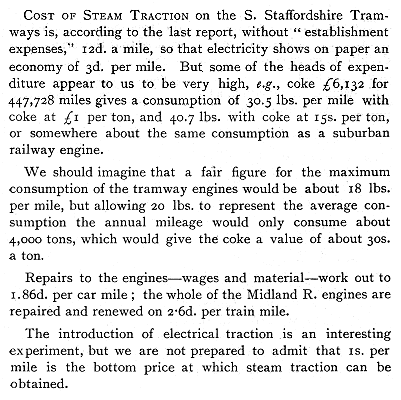 |
All of the electrical equipment was
made by the E.C.C. including two Elwell-Parker type 15hp. series-wound
motors for each car, and all of the control gear. The motor
controls and two sets of brake controls were fitted under
the stairs, and the motor-control resistances were fitted
under the floor. The poles for the overhead wire were
placed at the side of the road, and the bracket arms
carrying the trolley wire stretched out over the
road from 7 to 10 feet, giving a clear height of 21 feet. By a kind of
universal joint, as in Alfred Dickinson's patent, the
trolley was allowed a variation of several feet, so that the
wire didn't have to be directly over the middle of the
track. |
|
South Staffordshire Tramways.
From The Engineer, 18th November, 1892.
Early in the present year
the South Staffordshire Tramway Company entered
into a contract with the Electric Construction
Corporation, of Wolverhampton, for the equipment
of a section of its lines with plant for
electric traction on what is generally known as
the trolley wire system, the lines having
hitherto been worked by steam locomotives. The
plant is now practically completed, and the
inspection by General Hutchinson and Major
Cardew, on behalf of the Board of Trade, took
place on Saturday, November 12th, so that the
electric cars will very shortly come into
service.
The lines over which the electric cars are to
be run extend from the junction of Holyhead Road
and Bridge Street in Wednesbury, through the
centre of the borough of Walsall, to Bloxwich,
with two branch lines, one running from the
Pleck to Darlaston, and the other from Walsall
to Mellish Road. The length of streets occupied
by the tramways is just over eight miles, six
miles having a single line with turn-outs, the
other two miles having a double line, making a
total length of track, and therefore of trolley
wire, of over ten miles. The route taken by the
lines is shown on the map - Fig. 5 - which also
indicates the position of the generating station
on the line between the Pleck and Darlaston.
|
|

Fig. 5. A map of the tramway. |
|

The generating station at Pleck, Walsall. |
|
The generating station is
on the side of the canal, and has a basin for
receiving the barges bringing coal, which
discharge directly into the boiler room. The
canal water is used for condensing.
The general arrangement of
the buildings and plant is shown on the plan and
section - Figs. 6 and 7. The three boilers are
of the Lancashire type, 7ft. diameter, 30ft. in
length, designed for a working pressure of 120
lb. per square inch. The three engines, which,
together with the boilers, were made by Messrs.
J. Musgrave and Sons, of Bolton, are of the
horizontal coupled-compound pattern, each easily
capable of indicating 125 horse power with the
above steam pressure, when running at a speed of
100 revolutions per minute. The cylinders are
10½in. and 20in. diameter, 30in. stroke, both
cylinders being fitted with Corliss valve gear;
the flywheels are 10ft. in diameter, and grooved
for seven l¼in. diameter ropes. A surface
condenser is attached to each engine. The steam
and feed pipes are arranged so as to give a
duplicate service between the engines, boilers,
and pumps. |
|
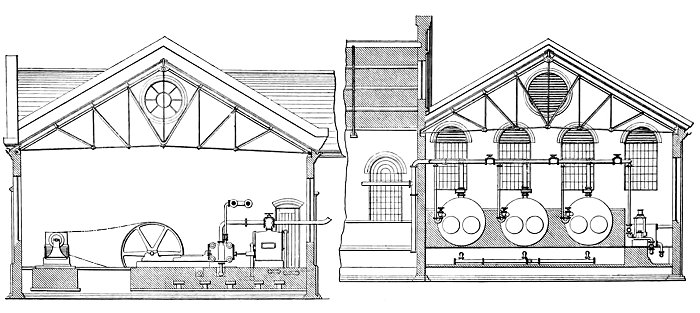
Fig. 6. The generating station. |
|
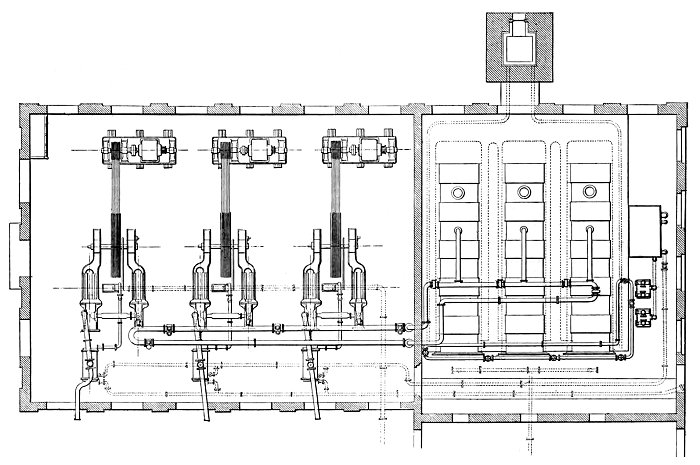
Fig. 7. A plan of the generating station. |
| Arrangements are also provided so that the
engines can be run non-condensing if required.
The dynamos, one of which is driven from each
engine by means of cotton ropes, are of the
usual Elwell-Parker type, and give an output of
260 amperes at 300 volts, when running 400
revolutions per minute, the field magnets being
shunt wound. The driving pulleys are carried
between two bearings, and there is a coupling
between the pulley and armature shafts, so that
the latter can at any time be removed without
taking off the ropes or dismounting the pulley. |
| Each dynamo is connected by cables carried
under the floor to a patent Elwell-Parker
automatic magnetic contact, which also acts as
the main switch for the machine. These
contacts are adjusted so that, in the event of
an excessive current being demanded from the
machines - due to any accident or short circuit
on the lines - the circuit is opened, and any
damage to the machines prevented.
All three machines feed in parallel on to
common omnibus bars, between which and the
feeders taking current out to the line there is
a simple main switch. Ammeters are provided in
each dynamo circuit, and a voltmeter with large
dial indicates the electromotive force across
the omnibus bars.
Multiple contact switches and resistance
coils are connected in the shunt circuits for
regulating the electromotive force.
A section of the switchboard showing the
arrangement for each machine is illustrated in
Fig. 4. |
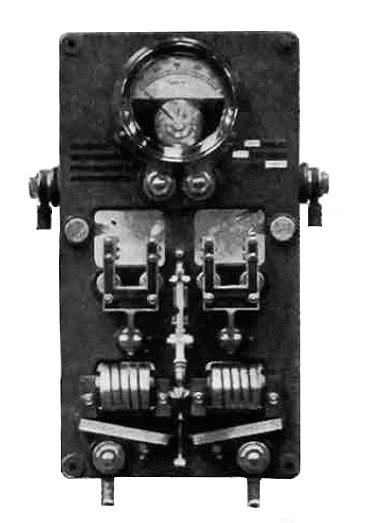
Fig. 4. The switchboard. |
|
From the generating station
the current is supplied to the 0 gauge copper
trolley wire by underground feeders, these being
insulated with vulcanised bitumen, lead
sheathed, and armoured with a double layer of
steel tape, so that they can be laid directly in
the ground without further protection; the
lengths and sections of the feeders are
indicated in the map - Fig. 5.
The return circuit is
completed through the rails and earth. At
distances of approximately half a mile apart
connections are made between the feeders and
trolley wire by means of cables drawn up inside
the posts. Each section of trolley wire is fed
into at both ends, the current passing through
fuses placed in an underground box - Fig. 8 - at
the foot of the feeding posts. These fuse boxes
are made on the diving bell principle, to
prevent any possibility of water accumulating in
them and rising sufficiently high to reach the
connection. The covers are easily drawn up to
allow of examination or insertion of new fuses.
The map - Fig. 5 - shows the position of the
feeding points and fuses. |
|
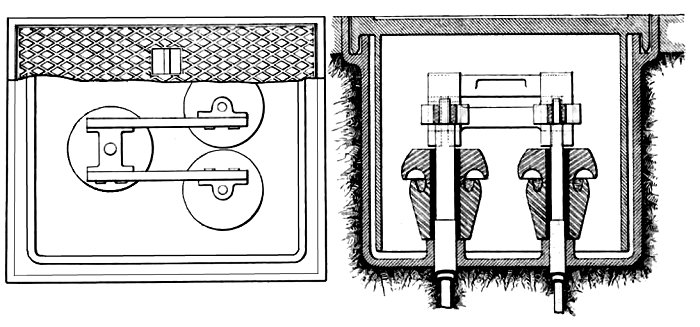
Fig. 8. Underground fuse boxes. |
| The trolley wire is carried at a height of
20ft. from the surface of the streets by poles
along one side of the road only; arms projecting
from the poles - Fig. 7 - carry the insulators
supporting the wire. A special arrangement,
suggested by Mr. Dickinson, the Tramway
Company's engineer, makes it unnecessary that
the trolley wire should be at a regular distance
from the centre of the rails, the collector
being designed so as to allow a variation of
several feet. Where there is a double line of
rails the pole arm carries two insulators and
two trolley wires, one for the up and one for
the down line. Automatic overhead switches are
fixed at the turn-outs, so as to guide the
collector wheel along the right wire. Fourteen
cars made by Messrs. Brown, Marshall, and Co.,
and the Lancaster Wagon Company, are being
supplied for the equipment of the line, each
carrying forty passengers, eighteen inside and
twenty-two outside. The collector is fixed on
one side of the roof of the car, the arrangement
being clearly shown in Fig. 7. |
|
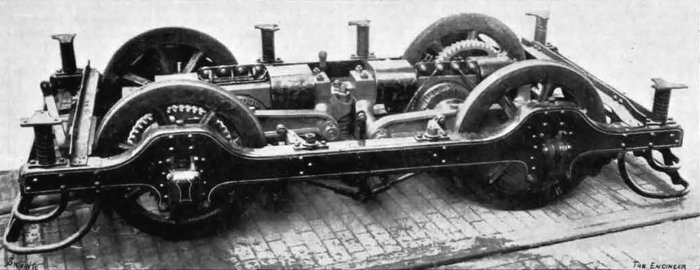
Fig. 2. An under truck with motors. |
|
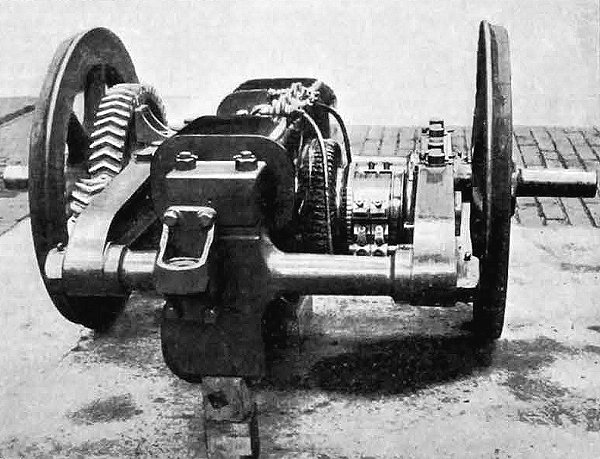
Fig. 3. An Elwell-Parker motor. |
| The under trucks - Fig. 2 - carry two Elwell-Parker
series wound motors - Fig. 3 - each capable of
running continuously with a load of 15
horsepower, the normal speed being 400
revolutions per minute; the armatures are geared
up to the axles by means of cast steel double
helical wheels and pinions, having a ratio of 4
to 1. One motor is considered to be amply
sufficient to take a fully loaded car up the
heaviest gradient of 1 in 28 occurring on the
line. The practice of using two motors on each
car appears to have been brought over from
America, where the lines are not so well laid,
and where, also, they have to contend with snow
and ice throughout the winter. On very few lines
in England do we consider that it will be
necessary to use two motors, although it will be
necessary that the one motor shall be more than
15 horsepower, unless a simple form of gear for
varying the speed with a constant speed of motor
be used. Driving switches are fitted at both
ends of the car, and arranged so that either or
both of the motors can be in use, the regulation
of speed being effected by putting resistance
into the motor circuit. The
whole of the electrical plant has been designed,
manufactured, and installed by the Electric
Construction Corporation, who are also
responsible for the other portion of the plant
supplied to them by various firms as
sub-contractors. The running of the line is also
in the hands of the Electric Construction
Corporation, they having undertaken to work it
at a fixed charge per car mile for a number of
years. Mr. Alfred Dickinson has been appointed
to superintend the working on their behalf. |
|
|
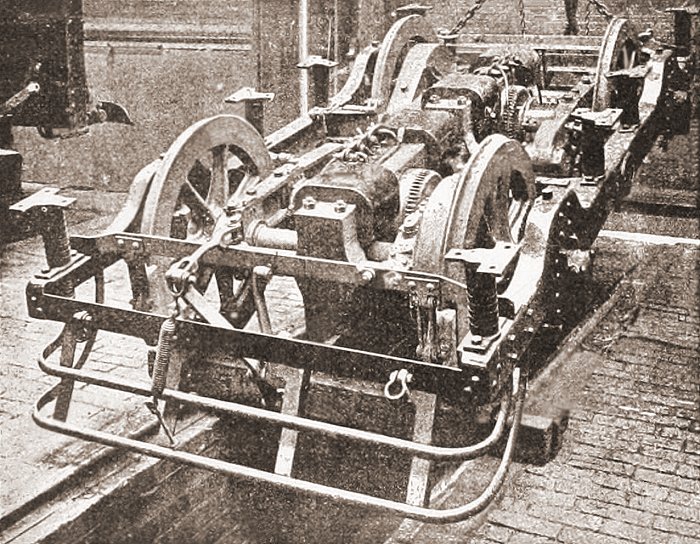
Another photo of an Elwell-Parker
under truck. |
|
The Line in Operation
The electrification work had been completed by November,
and so the Board of Trade inspection was carried out on
Saturday 12th November by Mayor General Hutchinson and Major
Cardew. They arrived by train at James Bridge Station and
were met by a large party including the mayors and officials
from Walsall and Wednesbury, several of the tramway
company's directors, Alfred Dickinson, and Thomas Parker from
the E.C.C. They boarded one of the new trams and travelled
to Darlaston depot, where the motors were inspected. The
party then re-boarded the tram and travelled back along the
same route to Pleck generating station for an inspection of
the mechanical and electrical machinery. Afterwards they
travelled in the tram over all of the electrified lines, which
were duly inspected.
Mayor General Hutchinson's favourable report arrived on
21st November and the official opening ceremony took place
at Pleck generating station on Saturday 31st December.
Guests included the Bishop of Lichfield, the mayors of
Walsall, Wednesbury and West Bromwich, the chairman and
directors of the tram company, and directors of the E.C.C.
The current was turned on by Mrs Carruthers Wain, and the
party proceeded in one of the new trams to the drill hall in
Walsall for lunch.
The new trams began running on 1st January, 1893. The
E.C.C. appointed Alfred Dickinson to oversee the working of
the line. They were operated by the E.C.C. as agreed in the
terms of the contract. The tramway company then paid the
E.C.C. 4½ pence per operational
mile. Eight of the new trams were based at the Darlaston
depot, and eight at Birchills. Each driver and conductor was
responsible for the operation of their tram, which they ran
for six days a week. On the seventh day it was
checked-over at the depot. No uniforms were supplied.
Drivers usually wore a bowler hat, and conductors had an
ordinary flat cap.
The new system worked well,
much to everyone's satisfaction. In the first twelve months
of operation the electric tramcars ran 262,692 miles and carried
1,668,057 passengers, at a cost of just 4.06 pence per mile,
compared with 7.04 pence for the steam trams. Although the
electrification had been a great success, the tram company
faced an uncertain future. Some of the shareholders were
extremely unhappy with the company, and in April and May,
1894 they urged their fellow shareholders to sign a petition
asking for the winding-up of the company. The petition was
presented by Mr. Alfred Dawson and other shareholders to Mr.
Justice Vaughan Williams in the Chancery Division of the
High Court of Justice. It made allegations of fraud, and
stated that the shareholders wanted more say in the running
of the company, and a new chairman. As a result, an
extraordinary meeting of the shareholders was held on 12th
June, and a new Board elected. They were: Chairman - Alftred Dawson,
Directors - William Somers
Schuster, and Samuel Richardson Blundstone.
| The April 1894 timetable for
the electric tramcars includes details of a fifteen minute
service between Bloxwich and Wednesbury via Walsall, and a
half hourly service between Darlaston and Mellish Road,
Walsall, via The Bridge.
The fare from Darlaston to The
Bridge was three pence, as was the fare from The Bridge to
Wednesbury.
Return tickets and season tickets could also be
purchased. |
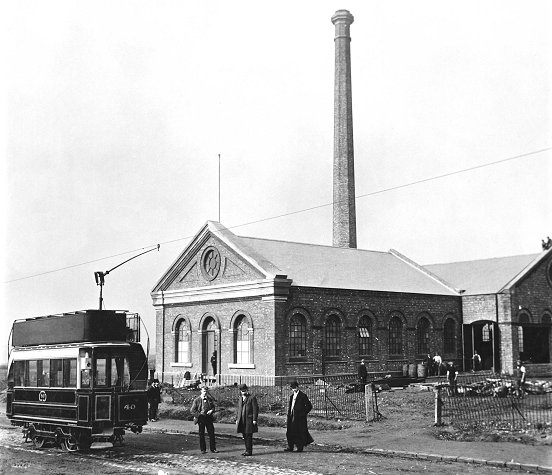
Another view of Pleck
generating station, possibly taken during an early
inspection. |
Stormy Times
The company remained in a
poor financial state, so much so that the E.C.C. announced
that as from midnight on Friday 14th December, 1894, it
would end its contract with the tramway. The E.C.C. claimed
that it was owed between £7,000 and £8,000 by the tram
company. The sudden stoppage came as a blow to many people.
The electric trams had been very popular, operating a
frequent and punctual service that had become a necessity
for much of the local population. The Mayor and Town Clerk
of Walsall stepped-in to try and resolve the problem in
order to get the trams running again. Agreement was reached
between the two parties, and the trams began running again
on 22nd December, but from the 7th January, 1895 the fifteen
minute service on the Bloxwich, Walsall, and Wednesbury
route became half hourly. The fifteen minute service was reinstated in the
following September.
On 18th August, 1895 Mr.
Alfred Dickinson J.P., C.E. left the company to form his
own business in Birmingham as a tramway consultant. He was
replaced by Mr. J. J. Robins, but remained in overall charge
of the electrified lines on behalf of the E.C.C.
Problems resurfaced towards
the end of 1895 when the E.C.C. informed the local councils
that it could not continue to operate the line after the end
of the year because of the dreadful condition of the track,
which was in bad need of repair. Some work must have been
carried out because the trams continued to run.
In 1896 the tram company
became involved in two court cases. The first in February
was against Joseph Ebbsmith and W. J. Caruthers which
resulted in the company being awarded £12,845 plus costs.
The second involved the E.C.C. which was still asking for
the money it was owed. The case, held in the Chancery Court was
won by the E.C.C. and resulted in long-term negotiations
between the two companies. By June 1897 a provisional
agreement had been reached. The E.C.C. took-up an
interest in the tramway company and received a lease on
the electrical tramways.
Towards the end of 1896 the
newly formed British Electric Traction Company attempted,
but failed, to promote a Bill in Parliament to enable it to
take-over all of the local tramways, including the South
Staffs, and form a unified electrically-powered system.
After the failure of the Bill, B.E.T. began to contact
individual companies, and local authorities with the
intention of taking-over individual lines. On 11th June,
1897 it reached an agreement with the E.C.C. in which the
E.C.C. handed-over its entire interest in the tramway in
exchange for £50,000 in debentures. This was assigned to BET
by an indenture dated 29th July, 1897 which gave BET a
controlling interest in the company.
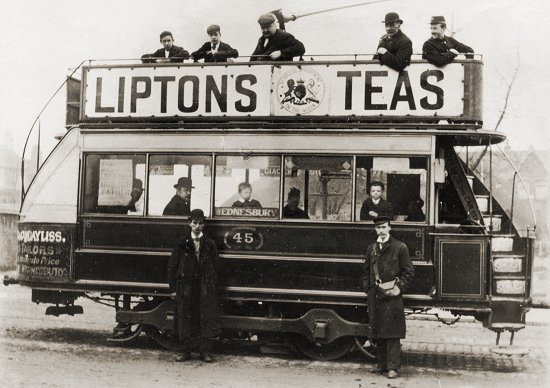
Another view of one of the electric
tramcars.
The story continues in
the following sections:
|
 |
Return to the
electric trams menu |
|